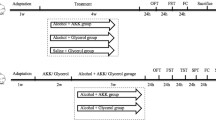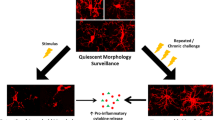The influence of the dimeric dipeptide mimetic of brain-derived neurotrophic factor (BDNF) bis(N-monosuccinyl-L-seryl-L-lysine) hexamethylenediamide (GSB-106, dosage form) during three-day peroral administration at a dose of 0.1 mg/kg on the 1% sucrose solution preference test and the content of postsynaptic density protein (PSD-95) in the prefrontal cortex and hippocampus of C57Bl/6 mice was studied in an acute three-day social defeat stress model. The preference for sucrose solution decreased and the PSD-95 content in the prefrontal cortex was halved statistically significantly in stressed mice as compared to control animals. The hippocampal PSD-95 content in stressed animals did not change. Anhedonia was completely prevented after each stress session according to the sucrose preference test with peroral administration of GSB-106 at a dose of 0.1 mg/kg once per day for three days. GSB-106 did not reduce the prefrontal PSD-95 content of stressed animals during the experiment.

Similar content being viewed by others
References
T. A. Gudasheva, A. V. Tarasyuk, S. V. Pomogaibo, et al., Bioorg. Khim., 38(3), 280 – 290 (2012).
T. A. Gudasheva, I. O. Logvinov, T. A. Antipova, and S. B. Seredenin, Dokl. Akad. Nauk, 448(5), 577 – 580 (2013); https://doi.org/10.7868/S0869565213240250.
T. A. Gudasheva, P. Yu. Povarnina, and S. B. Seredenin, Byull. Eksp. Biol. Med., 162(10), 448 – 451 (2016).
T. A. Gudasheva, P. Yu. Povarnina, T. A. Antipova, and S. B. Seredenin, Dokl. Biochem. Biophys., 481(1), 225 – 227 (2018); https://doi.org/10.1134/S1607672918040130.
S. B. Seredenin, T. A. Voronina, T. A. Gudasheva, et al., Acta Nat., 5(4)(19), 116 – 120 (2013).
P. Yu. Povarnina, T. L. Garibova, T. A. Gudasheva, and S. B. Seredenin, Acta Nat., 10(3) (38), 81 – 84 (2018).
A. V. Tallerova, P. Yu. Povarnina, E. V. Blynskaya, et al., Khim.-farm. Zh., 52(5), 15 – 17 (2018).
T. A. Gudasheva, P. Y. Povarnina, T. A. Tallerova, et al., Int. J. Pharm. Sci. Sci. Res., 4(7), 74 – 79 (2018).
R. S. Duman, G. K. Aghajanian, G. Sanacora, et al., Nat. Med., 22(3), 238 – 249 (2016).
E. Y. Yuen, W. Liu, I. N. Karatsoreos, et al., Proc. Natl. Acad. Sci. USA, 106(33), 14075 – 14079 (2009).
R. S. Duman, F1000Research, 7(659), 1 – 10(2018).
S. Yashiro and K. Seki, Stress, 20(4), 404 – 418 (2017).
T. Rantamaki, Cell Tissue Res., 377, 155 – 124 (2019).
T. Rantamaki, P. Hendolin, A. Kankaanpaa, et al., Neuropsychopharmacology, 32(10), 2152 – 2162 (2007).
F. C. Vilela, M. de M. Padilha, G. Alves-Da-Silva, et al., J. Med. Food, 13(1), 219 – 222 (2010).
T. Strekalova, R. Spanagel, D. Bartsch, et al., Neuropsychopharmacology, 29, 2007 – 2017 (2004).
L. Musazzi, P. Tornese, N. Sala, et al., Front. Pharmacol., 9(758), 1 – 13(2018).
J. C. Zhang, W. Yao, C. Dong, et al., Psychopharmacology, 232(23), 4325 – 4335 (2015).
Acknowledgments
The work was performed in the framework of a State Task for 2019 – 2021 on topics No. 0521-2019-0003 “Search for pharmacological methods for selective activation of signaling pathways of tyrosine-kinase neurotrophin receptors as platforms for creating drugs free of the side effects of native neurotrophins” and No. 0521-2019-0002 “Development of new agents and methods for pharmacotherapy of anxiety and depression.”
Author information
Authors and Affiliations
Corresponding author
Additional information
Translated from Khimiko-Farmatsevticheskii Zhurnal, Vol. 54, No. 5, pp. 3 – 6, May, 2020.
Rights and permissions
About this article
Cite this article
Tallerova, A.V., Mezhlumyan, A.G., Povarnina, P.Y. et al. GSB-106 Dipeptide Mimetic of Brain-Derived Neurotrophic Factor Prevents Anhedonia Development under Acute Social Defeat Stress Conditions in Mice. Pharm Chem J 54, 431–434 (2020). https://doi.org/10.1007/s11094-020-02217-8
Received:
Published:
Issue Date:
DOI: https://doi.org/10.1007/s11094-020-02217-8




